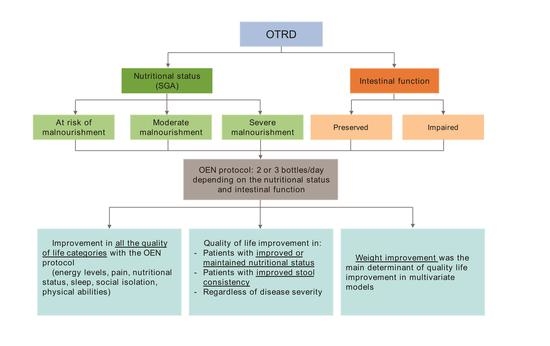Impact of an Oral Nutritional Protocol with Oligomeric Enteral Nutrition on the Quality of Life of Patients with Oncology Treatment-Related Diarrhea
Abstract
1. Introduction
2. Materials and Methods
2.1. Study Design
2.2. Study Outcomes
2.3. Statistical Analyses
3. Results
3.1. Study Population
3.2. QoL Improvement
4. Discussion
5. Conclusions
Author Contributions
Funding
Acknowledgments
Conflicts of Interest
References
- Elting, L.S.; Cooksley, C.; Chambers, M.; Cantor, S.B.; Manzullo, E.; Rubenstein, E.B. The burdens of cancer therapy: Clinical and economic outcomes of chemotherapy-induced mucositis. Cancer 2003, 98, 1531–1539. [Google Scholar] [CrossRef] [PubMed]
- Grant, M.; Kravits, K. Symptoms and their impact on nutrition. Semin. Oncol. Nurs. 2000, 16, 113–121. [Google Scholar] [CrossRef] [PubMed]
- Andreyev, J.; Ross, P.; Donnellan, C.; Lennan, E.; Leonard, P.; Waters, C.; Wedlake, L.; Bridgewater, J.; Glynne-Jones, R.; Allum, W.; et al. Guidance on the management of diarrhoea during cancer chemotherapy. Lancet Oncol. 2014, 15, e447–e460. [Google Scholar] [CrossRef]
- Thompson, K.L.; Elliott, L.; Fuchs-Tarlovsky, V.; Levin, R.M.; Voss, A.C.; Piemonte, T. Oncology Evidence-Based Nutrition Practice Guideline for Adults. J. Acad. Nutr. Diet. 2017, 117, 297–310.e47. [Google Scholar] [CrossRef]
- Li, J. Diarrhea with HER2-Targeted Agents in Cancer Patients: A Systematic Review and Meta-Analysis. J. Clin. Pharmacol. 2019, 59, 935–946. [Google Scholar] [CrossRef]
- Bozzetti, F. Quality of life and enteral nutrition. Curr. Opin. Clin. Nutr. Metab. Care 2008, 11, 661–665. [Google Scholar] [CrossRef]
- Tarricone, R.; Abu Koush, D.; Nyanzi-Wakholi, B.; Medina-Lara, A. A systematic literature review of the economic implications of chemotherapy-induced diarrhea and its impact on quality of life. Crit. Rev. Oncol. Hematol. 2016, 99, 37–48. [Google Scholar] [CrossRef]
- Viele, C.S. Overview of Chemotherapy-Induced Diarrhea. Semin. Oncol. Nurs. 2003, 19, 2–5. [Google Scholar] [CrossRef][Green Version]
- de van der Schueren, M.A.E.; Laviano, A.; Blanchard, H.; Jourdan, M.; Arends, J.; Baracos, V.E. Systematic review and meta-analysis of the evidence for oral nutritional intervention on nutritional and clinical outcomes during chemo(radio)therapy: Current evidence and guidance for design of future trials. Ann. Oncol. 2018, 29, 1141–1153. [Google Scholar] [CrossRef]
- Dranitsaris, G.; Maroun, J.; Shah, A. Estimating the cost of illness in colorectal cancer patients who were hospitalized for severe chemotherapy-induced diarrhea. Can. J. Gastroenterol. 2005, 19, 83–87. [Google Scholar] [CrossRef]
- Cotogni, P.; Pedrazzoli, P.; De Waele, E.; Aprile, G.; Farina, G.; Stragliotto, S.; De Lorenzo, F.; Caccialanza, R. Nutritional therapy in cancer patients receiving chemoradiotherapy: Should we need stronger recommendations to act for improving outcomes? J. Cancer 2019, 10, 4318–4325. [Google Scholar] [CrossRef] [PubMed]
- Polański, J.; Jankowska-Polańska, B.; Uchmanowicz, I.; Chabowski, M.; Janczak, D.; Mazur, G.; Rosińczuk, J. Malnutrition and Quality of Life in Patients with Non-Small-Cell Lung Cancer. In Advances in Experimental Medicine and Biology—Neuroscience and Respiration; Springer: Berlin/Heidelberg, Germany, 2017; Volume 6, pp. 15–26. ISBN 978-3-319-65469-0. [Google Scholar]
- Baldwin, C.; Spiro, A.; Ahern, R.; Emery, P.W. Oral nutritional interventions in malnourished patients with cancer: A systematic review and meta-analysis. J. Natl. Cancer Inst. 2012, 104, 371–385. [Google Scholar] [CrossRef] [PubMed]
- Cederholm, T.; Barazzoni, R.; Austin, P.; Ballmer, P.; Biolo, G.; Bischoff, S.C.; Compher, C.; Correia, I.; Higashiguchi, T.; Holst, M.; et al. ESPEN guidelines on definitions and terminology of clinical nutrition. Clin. Nutr. 2017, 36, 49–64. [Google Scholar] [CrossRef] [PubMed]
- Benson, A.B.; Ajani, J.A.; Catalano, R.B.; Engelking, C.; Kornblau, S.M.; Martenson, J.A.; McCallum, R.; Mitchell, E.P.; O’Dorisio, T.M.; Vokes, E.E.; et al. Recommended guidelines for the treatment of cancer treatment-induced diarrhea. J. Clin. Oncol. 2004, 22, 2918–2926. [Google Scholar] [CrossRef]
- Peterson, D.E.; Boers-Doets, C.B.; Bensadoun, R.J.; Herrstedt, J. Management of oral and gastrointestinal mucosal injury: ESMO Clinical Practice Guidelines for diagnosis, treatment, and follow-up. Ann. Oncol. 2015, 26, v139–v151. [Google Scholar] [CrossRef]
- Wedlake, L.J.; Shaw, C.; Whelan, K.; Andreyev, H.J.N. Systematic review: The efficacy of nutritional interventions to counteract acute gastrointestinal toxicity during therapeutic pelvic radiotherapy. Aliment. Pharmacol. Ther. 2013, 37, 1046–1056. [Google Scholar] [CrossRef]
- Arends, J.; Bachmann, P.; Baracos, V.; Barthelemy, N.; Bertz, H.; Bozzetti, F.; Fearon, K.; Hütterer, E.; Isenring, E.; Kaasa, S.; et al. ESPEN guidelines on nutrition in cancer patients. Clin. Nutr. 2017, 36, 11–48. [Google Scholar] [CrossRef]
- Sanz-Paris, A.; Martinez-García, M.; Martinez-Trufero, J.; Lambea-Sorrosal, J.; Calvo-Gracia, F.; López-Alaminos, M.E. Oligomeric enteral nutrition in undernutrition, due to oncology treatment-related diarrhea. Systematic review and proposal of an algorithm of action. Nutrients 2019, 11, 1888. [Google Scholar] [CrossRef]
- Sanz-Paris, A.; Martinez-Trufero, J.; Lambea-Sorrosal, J.; Calvo-Gracia, F.; Milà-Villarroel, R. Clinical and Nutritional Effectiveness of a Nutritional Protocol with Oligomeric Enteral Nutrition in Patients with Oncology Treatment-Related Diarrhea. Nutrients 2020, 12, 1534. [Google Scholar] [CrossRef]
- Hunt, S.M.; McEwen, J.; McKenna, S.P. Measuring health status: A new tool for clinicians and epidemiologists. J. R. Coll. Gen. Pract. 1985, 35, 185–188. [Google Scholar]
- Alonso, J.; Anto, J.M.; Moreno, C. Spanish version of the Nottingham Health Profile: Translation and preliminary validity. Am. J. Public Health 1990, 80, 704–708. [Google Scholar] [CrossRef] [PubMed]
- Montazeri, A.; Milroy, R.; Gillis, C.R.; McEwen, J. Quality of life (QOL) in patients with lung cancer: An important prognostic factor. Thorax 1996, 51, 233–240. [Google Scholar]
- Ravasco, P.; Monteiro-Grillo, I.; Marques Vidal, P.; Camilo, M.E. Cancer: Disease and nutrition are key determinants of patients’ quality of life. Support. Care Cancer 2004, 12, 246–252. [Google Scholar] [PubMed]
- Zhu, M.W.; Yang, X.; Xiu, D.R.; Yang, Y.; Li, G.X.; Hu, W.G.; Wang, Z.G.; Cui, H.Y.; Wei, J.M. Effect of oral nutritional supplementation on the post-discharge nutritional status and quality of life of gastrointestinal cancer patients after surgery: A multi-center study. Asia Pac. J. Clin. Nutr. 2019, 28, 450–456. [Google Scholar]
- Ziętarska, M.; Krawczyk-Lipiec, J.; Kraj, L.; Zaucha, R.; Małgorzewicz, S. Chemotherapy-related toxicity, nutritional status and quality of life in precachectic oncologic patients with, or without, high protein nutritional support. A prospective, randomized study. Nutrients 2017, 9, 1108. [Google Scholar] [CrossRef]
- Löfdahl, E.; Berg, G.; Johansson, K.A.; Zachrisson, M.L.; Malmgren, H.; Mercke, C.; Olsson, E.; Wiren, L.; Johannsson, G. Compromised quality of life in adult patients who have received a radiation dose towards the basal part of the brain. A case-control study in long-term survivors from cancer in the head and neck region. Radiat. Oncol. 2012, 7, 1–10. [Google Scholar] [CrossRef] [PubMed]
- Capatina, C.; Christodoulides, C.; Fernandez, A.; Cudlip, S.; Grossman, A.B.; Wass, J.A.H.; Karavitaki, N. Current treatment protocols can offer a normal or near-normal quality of life in the majority of patients with non-functioning pituitary adenomas. Clin. Endocrinol. 2013, 78, 86–93. [Google Scholar] [CrossRef]
- Bianchi, G.; Loguercio, C.; Sgarbi, D.; Abbiati, R.; Brunetti, N.; De Simone, T.; Zoli, M.; Marchesini, G. Reduced quality of life of patients with hepatocellular carcinoma. Dig. Liver Dis. 2003, 35, 46–54. [Google Scholar] [CrossRef]
- Marín Caro, M.M.; Laviano, A.; Pichard, C. Nutritional intervention and quality of life in adult oncology patients. Clin. Nutr. 2007, 26, 289–301. [Google Scholar] [CrossRef] [PubMed]
- Kong, H.; Kwon, O.K.; Yu, W. Changes of quality of life after gastric cancer surgery. J. Gastric Cancer 2012, 12, 194–200. [Google Scholar] [CrossRef] [PubMed][Green Version]
- Fuji, S.; Mori, T.; Khattry, N.; Cheng, J.; Do, Y.R.; Yakushijin, K.; Kohashi, S.; Fukuda, T.; Kim, S.W. Severe weight loss in 3 months after allogeneic hematopoietic SCT was associated with an increased risk of subsequent non-relapse mortality. Bone Marrow Transplant. 2015, 50, 100–105. [Google Scholar] [CrossRef] [PubMed]
- Reynolds, C.; Spira, A.I.; Gluck, L.; Mueller, S.E.; Zhan, F.; Boehm, K.A.; Asmar, L. Sunitinib malate in previously untreated, nonsquamous, non-small cell lung cancer patients over the age of 70 years: Results of a Phase II trial. Investig. New Drugs 2013, 31, 1330–1338. [Google Scholar] [CrossRef] [PubMed]
- Campos, J.A.D.B.; da Silva, W.R.; Spexoto, M.C.B.; Serrano, S.V.; Marôco, J. Clinical, dietary and demographic characteristics interfering on quality of life of cancer patients. Einstein (São Paulo) 2018, 16, 1–8. [Google Scholar] [CrossRef] [PubMed]
- Hunt, S.M.; McKenna, S.P.; McEwen, J.; Williams, J.; Papp, E. The Nottingham health profile: Subjective health status and medical consultations. Soc. Sci. Med. Part A Med. Psychol. Med. Sociol. 1981, 15, 221–229. [Google Scholar] [CrossRef]
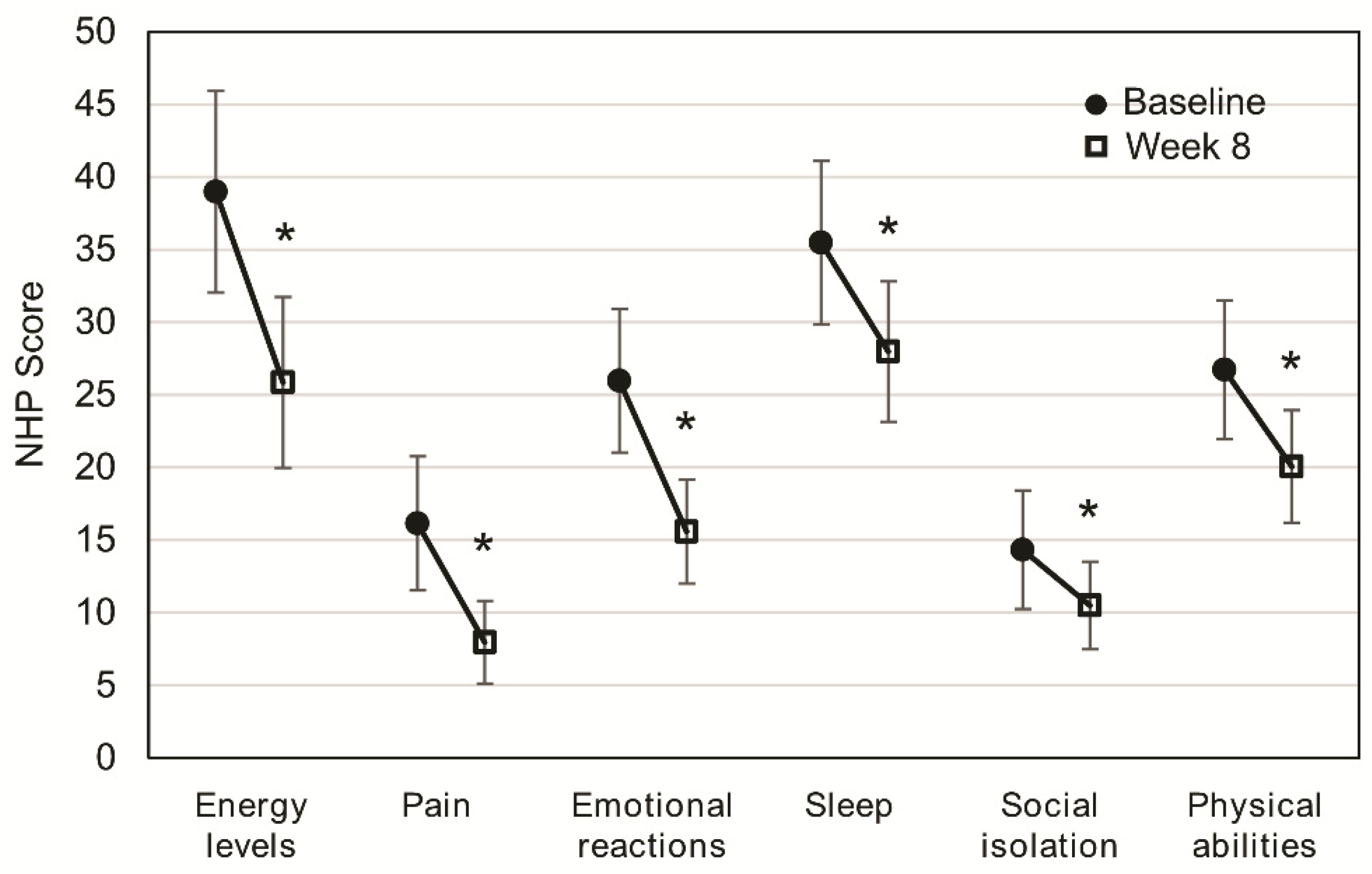
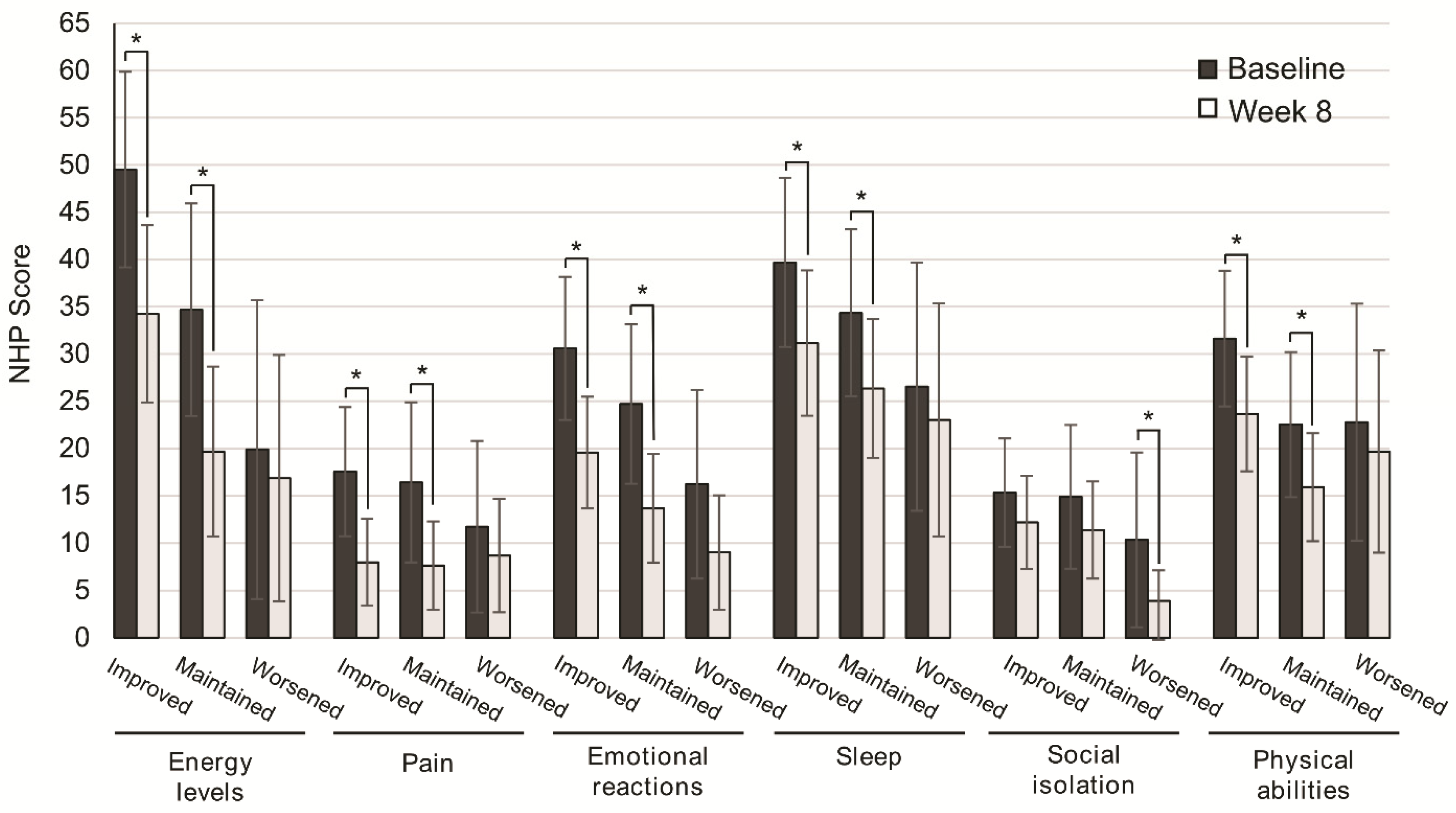
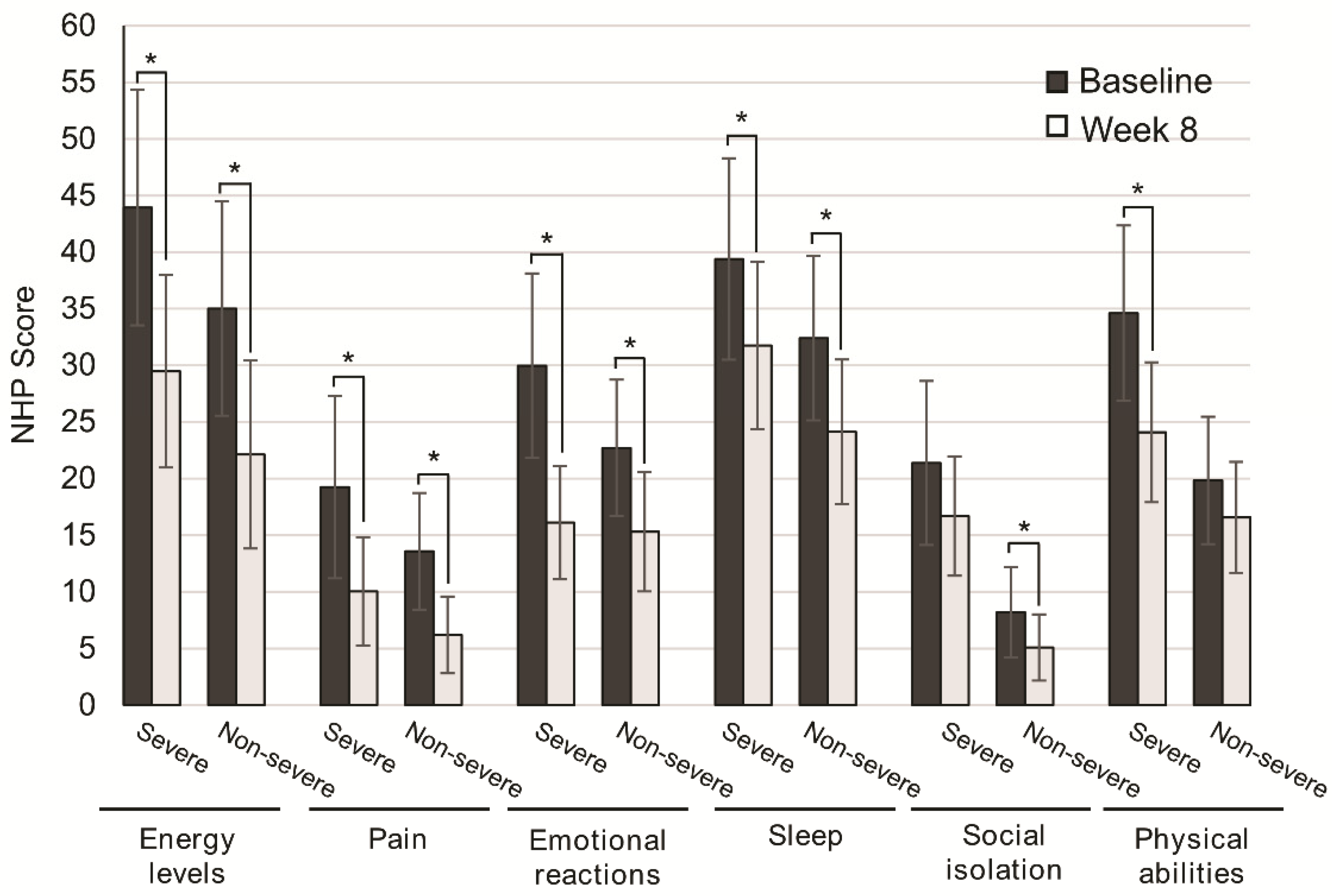
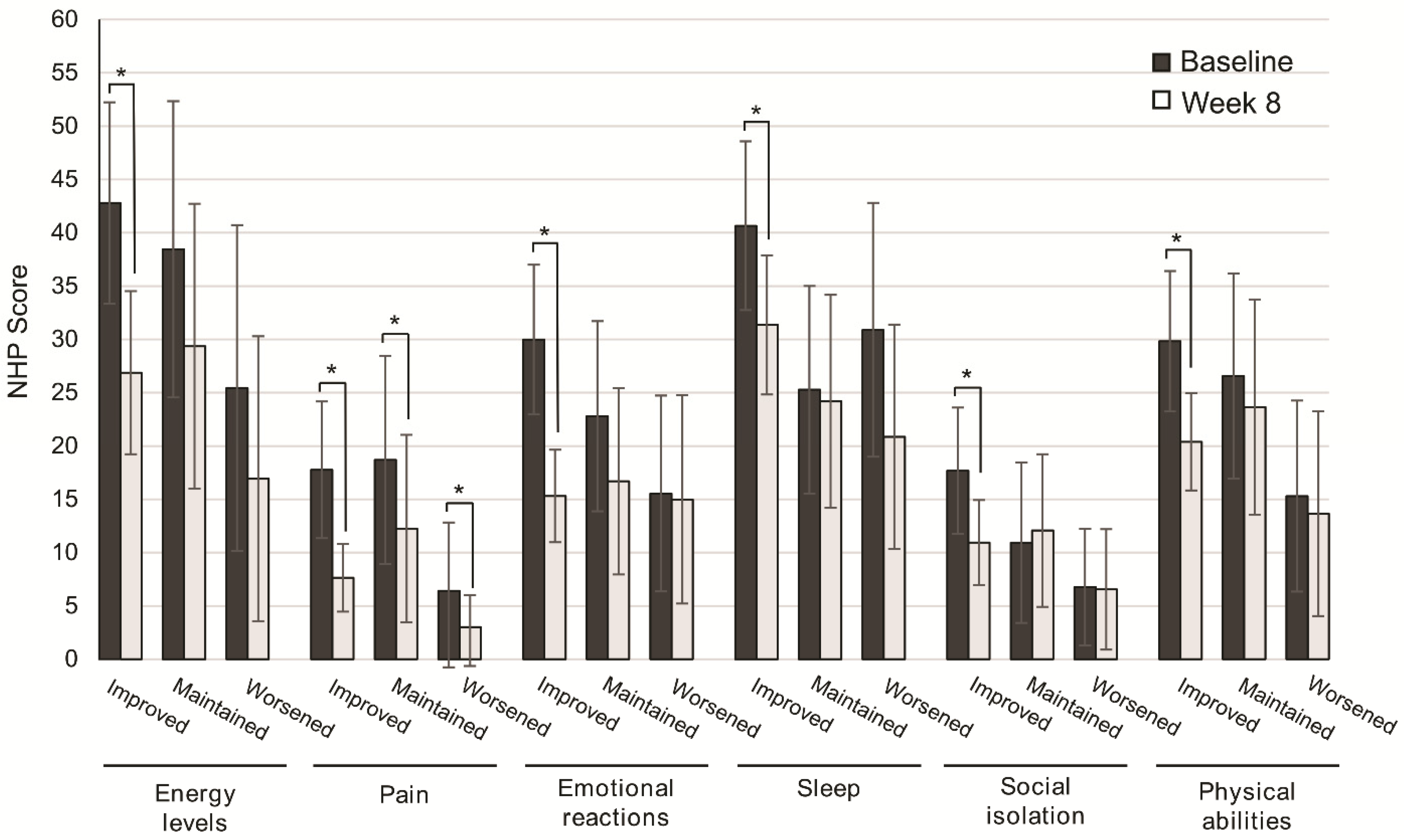
| Severe (n = 83) | Nonsevere (n = 52) | p-Value | |
|---|---|---|---|
| Age (years), Mean (SD) | 69.5 (12.8) | 66.2 (12.4) | 0.433 |
| Gender, (%) | |||
| Men | 47 (56.6%) | 28 (53.8%) | 0.752 |
| Women | 36 (43.4%) | 24 (46.2%) | |
| Weight (kg), Mean (SD) | 60.1 (12.1) | 65.4 (11.6) | 0.255 |
| BMI (kg/m2), Mean (SD) | 21.4 (3.2) | 23.6 (4.1) | 0.512 |
| Resectability (* n = 132) | |||
| Unresectable | 64 (80.0%) | 0 (0%) | <0.001 |
| Localized | 16 (20.0%) | 52 (100%) | |
| Type of treatment | |||
| Palliative | 62 (74.7%) | 0 (0%) | <0.001 |
| Curative | 21 (25.3%) | 52 (100%) | |
| Treatment modality | |||
| Chemotherapy | 46 (55.4%) | 7 (13.5%) | <0.001 |
| Radiotherapy | 9 (10.8%) | 12 (23.1%) | |
| Chemotherapy + Radiotherapy | 28 (33.7%) | 33 (63.5%) | |
| Targeted therapy (* n = 134) | |||
| Yes | 23 (27.7%) | 3 (5.9%) | 0.002 |
| No | 60 (72.3%) | 48 (94.1%) | |
| Type of tumor | |||
| Gynecologic/urologic | 9 (10.8%) | 14 (26.9%) | 0.023 |
| Digestive | 67 (80.7%) | 37 (71.2%) | |
| Other | 7 (8.4%) | 1 (1.9%) |
| Energy Levels | Pain | Emotional Reactions | Sleep | Social Isolation | Physical Abilities | |||||||
|---|---|---|---|---|---|---|---|---|---|---|---|---|
| Weight Change | OR (95% CI) | p | OR (95% CI) | p | OR (95% CI) | p | OR (95% CI) | p | OR (95% CI) | p | OR (95% CI) | p |
| OR (raw) | 3.28 (1.55–6.95) | 0.002 | 2.65 (1.2–5.9) | 0.017 | 4.2 (1.90–9.20) | <0.001 | 2.90 (1.30–6.50) | 0.012 | 0.96 (0.23–1.83) | 0.329 | 3.81 (1.79–8.12) | 0.001 |
| OR (adjusted) | 4.90 (1.83–9.03) | 0.000 | 3.79 (1.42–1.42) | 0.008 | 5.30 (2.1–2.05) | 0.001 | 4.19 (1.57–11.20) | 0.004 | 1.12 (0.39–3.27) | 0.83 | 4.95 (1.92–12.79) | 0.001 |
Publisher’s Note: MDPI stays neutral with regard to jurisdictional claims in published maps and institutional affiliations. |
© 2020 by the authors. Licensee MDPI, Basel, Switzerland. This article is an open access article distributed under the terms and conditions of the Creative Commons Attribution (CC BY) license (http://creativecommons.org/licenses/by/4.0/).
Share and Cite
Sanz-Paris, A.; Martinez-Trufero, J.; Lambea-Sorrosal, J.; Milà-Villarroel, R.; Calvo-Gracia, F.; on behalf of the DIAPOENO Study. Impact of an Oral Nutritional Protocol with Oligomeric Enteral Nutrition on the Quality of Life of Patients with Oncology Treatment-Related Diarrhea. Nutrients 2021, 13, 84. https://doi.org/10.3390/nu13010084
Sanz-Paris A, Martinez-Trufero J, Lambea-Sorrosal J, Milà-Villarroel R, Calvo-Gracia F, on behalf of the DIAPOENO Study. Impact of an Oral Nutritional Protocol with Oligomeric Enteral Nutrition on the Quality of Life of Patients with Oncology Treatment-Related Diarrhea. Nutrients. 2021; 13(1):84. https://doi.org/10.3390/nu13010084
Chicago/Turabian StyleSanz-Paris, Alejandro, Javier Martinez-Trufero, Julio Lambea-Sorrosal, Raimon Milà-Villarroel, Fernando Calvo-Gracia, and on behalf of the DIAPOENO Study. 2021. "Impact of an Oral Nutritional Protocol with Oligomeric Enteral Nutrition on the Quality of Life of Patients with Oncology Treatment-Related Diarrhea" Nutrients 13, no. 1: 84. https://doi.org/10.3390/nu13010084
APA StyleSanz-Paris, A., Martinez-Trufero, J., Lambea-Sorrosal, J., Milà-Villarroel, R., Calvo-Gracia, F., & on behalf of the DIAPOENO Study. (2021). Impact of an Oral Nutritional Protocol with Oligomeric Enteral Nutrition on the Quality of Life of Patients with Oncology Treatment-Related Diarrhea. Nutrients, 13(1), 84. https://doi.org/10.3390/nu13010084




